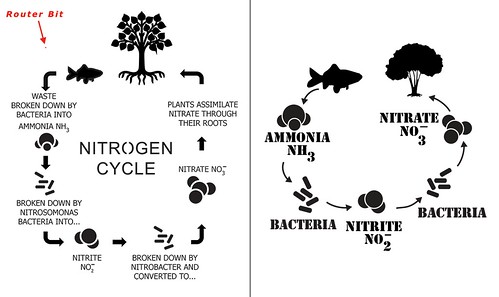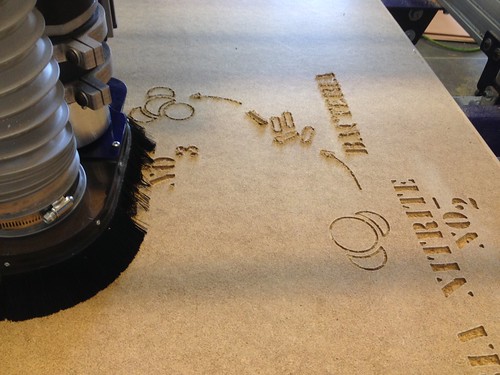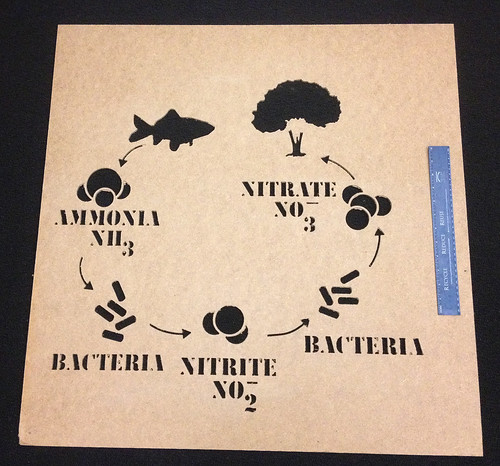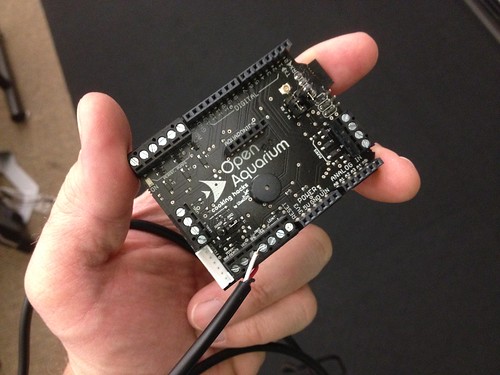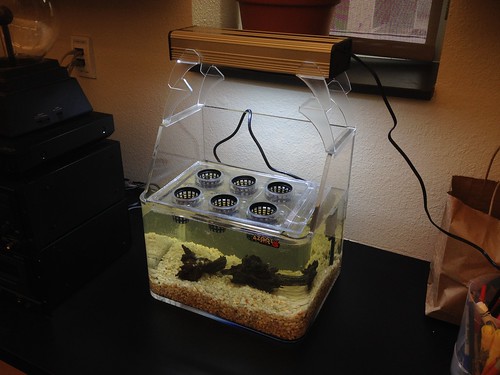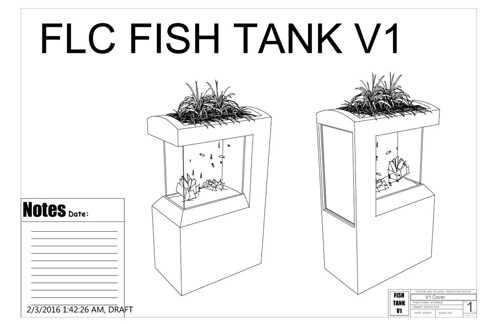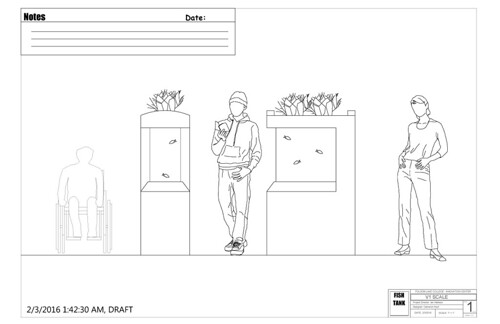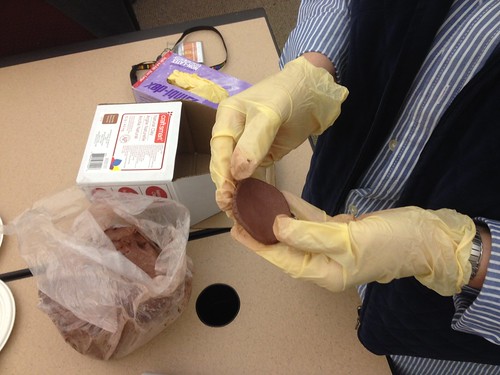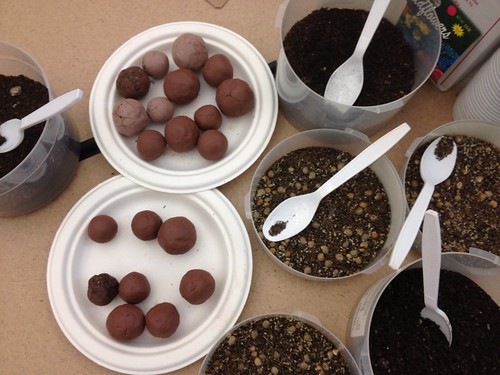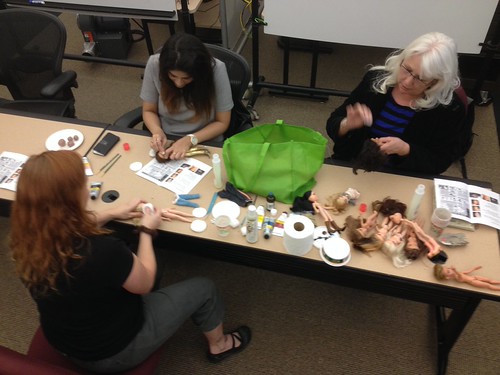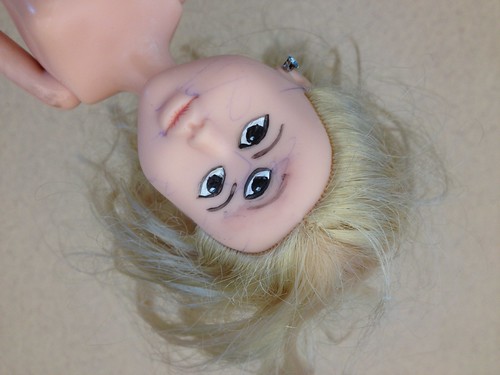Presentation slides:
https://docs.google.com/presentation/d/1OVpcJcAzrsXdBevLJypmvYy9U6ZXj3jMQo52LUHBKiA/edit?usp=sharing
Made some spectacular progress on the aquaponics project, producing a prototype of what will eventually be the light-up infographic built into the base. The team collaborated on a design for a diagram of the nitrogen cycle, and with the help of Ian Wallace (Professor, Theater Arts) and Cameron Hoyt (student and designer of the tank stand), we were able to get the design cut out on the big ShopBot in the scene shop.
Tools have their own logic, and CNC is no different. Balancing legibility of the design with the properties of the materials and the constraints of router bit size was a learning experience. The initial design was text heavy, but the 1/8″ bit introduces some size constraints. That is, the text has to be large enough for the machine to cut. After consulting with Ian, I scaled up many of the lines, adjusted the font, and created a little 1/8″ dot to drag around the image as a simulated router bit. The original is on the left, with the revised version on the right (below).
Ian took the draft diagram and ran it through software to create the tool path. Some scale work still to be done, especially on the text, but we decided to run a test cut anyhow.
I watched and learned as Cameron and Ian set up the ShopBot and got things ready to carve…
…after which I babysat the machine, which took about 30 minutes to cut out the prototype.
Below is the prototype, after a little cleanup with a knife, sandpaper and a file.
There’s still some design work to be done, and some tightening and scaling to make the diagram legible, but we were very pleased with this rough version. Always be prototyping!
The gear is beginning to roll in! As with any reasonably complex endeavor at any reasonably complex institution, procuring the “stuff” to make a project work takes a great deal of time and energy – lots of rules and forms and budget strings and signatures and hoops to be jumped through. For this particular project, the electronics – chiefly Arduino shields and associated sensors – are sourced from a Spanish company called Cooking Hacks. We chose this particular system because a) the parts seem to be well integrated and seemingly well thought out, and b) Cooking Hacks seems to have the code worked out, not just for the shields and sensor interfaces, but for the server-side bits that make the web integration work. In short, the goal is to get a prototype up and working with a minimum of coding and fuss, and the Cooking Hacks gear seems to fit the bill.
I was able to get most of the sensors working in relatively short order, so I’m feeling good about the progress. Still waiting on the purchase order for the tank itself, and the ECO-Cycle Aquaponics Kit for the top, but we were able to get a small test tank up and running, thanks to some spare parts the Biology Department was able to scrounge, and some help from Max Mahoney (Chemistry).
In addition to the little aquaponics setup above, we gathered up another unused 23-gallon tank, complete with filtration and gravel and all the parts necessary to bring up a complete “development instance” of the project in the Innovation Center, which we’ll use to test the electronics, and to get the water and filtration and fish and procedures sorted out. Progress!
Met with Cameron Hoyt (FLC Theater Arts student and primary design and construction resource for the project) to go over some initial design drawings. We talked through a bunch of considerations regarding size, scale, construction, safety, design, integration with the space, ease of access, cable routing, and other things. I’ll be seeking input from the other project primaries – Biology, Chemistry, and Library faculty – as we further refine the project and enter the build phase.
As part of Social Justice Spring, Diane Carlson (Sociology) and I presented a preview of the Making Social Change course we’ve been working on. Here’s a description of the session:
Join us for an interactive preview of a new course that will explore the intersections of social movements, technology, tools, and the maker movement. Come create, consider, collaborate, and culture jam!
Seed bombs…
and scrambled Bratz…
Presentation slides: https://docs.google.com/presentation/d/1SJTDnYs5oQglkyKP2CmsIKoqzbnU2IGkklahQrPKVB8/edit?usp=sharing
To request a testing account:
http://goo.gl/forms/FFxrjit5I2
If you requested your account prior to Feb. 17th (today), it should already be created.
To log in to the test instance of Canvas:
https://losrios.instructure.com/
Your default credentials will be:
Username: WID#
Password: 123456 (*note this is a temporary password, and you will see instructions to change it on the main page when you login)
You should see a testing course and two Orientation courses (Canvas Instructor Orientation and Canvas Student Orientation) on your Dashboard.
To Import content from D2L:
- In D2L: Export your D2L course (Edit Course -> Import/Export/Copy Components -> Export Components -> Start -> Download the *.zip file and note its location)
- In the test instance of Canvas: Import your D2L course (Dashboard -> Select your Test Course -> Settings -> Import Content into this Course -> Content Type: D2L export *.zip format -> Choose File -> Browse to the file you save in step 1 above -> Default Question bank: Create new question bank -> Content: All content -> Import)
Faculty Survey:
http://goo.gl/forms/zSEv7u2rmo
Student Survey:
http://goo.gl/forms/Ab1YAGgvd6
Important Note: Los Rios has not made a decision regarding the OEI and/or Canvas. The test instance of Canvas does not constitute in any way the acceptance by Los Rios of Canvas as an LMS for use in live courses.
Some things we could talk about…
Potential OEI Timelines (LMS Workgroup Options-v3-Jan2016), Faculty and Student Feedback, Training Options, etc.
ASCCC OER Session – OpenStax
Making Across the Curriculum: The Modern Maker Movement & Interdisciplinary Innovation
Zack Dowell
Folsom Lake College Innovation Center
Presentation Slides: https://docs.google.com/presentation/d/1aLTLU_dZL2yjY2i3b1HGOk1T9wIw3H2B5DZY50_li2o/edit?usp=sharing
Conference Information – http://www.asccc.org/events/2016-01-21-160000-2016-01-23-220000/2016-instructional-design-and-innovation

Legos and k’NEX – and people – working together with the help of the Free Universal Construction Kit.
- D2L, Canvas, and the OEI
- FLC DE Planning
- NMC Horizon Report 2015 (http://cdn.nmc.org/media/2015-nmc-horizon-report-HE-EN.pdf)
-
“When assessing the quality of courses, researchers pinpointed clarity, authenticity, unity, suspense, economy, depth, proportion, vividness, brilliance, sensitivity, emphasis, authority, flow, and precision as the ultimate benchmarks.”
-


